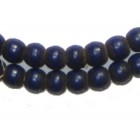Today, China has the monopoly on 21st century bead production. But it wasn’t always so. Prior to 1912, the country had little in the way of a bead industry to speak of; its economy largely dominated by farming and agricultural industries. It wasn’t until the 17th Century – the beginning of the Quing (or Ch’ing) Dynasty – that glass-makers began to realize the true economic potential of glass bead-making. Up until that point, only a handful of artisans were producing glass for anything other than commercial sale.
Competition among senior members of the royal court was rife in the 17th Century. Both men and women strived to outrank one another in terms of style and extravagant displays of wealth, just so they would be accepted by those in the upper echelons of society. Like jewels and gold, heavy embroidered fabrics were considered trademarks of wealth and aristocracy. Those that couldn’t afford expensive diamonds commissioned glass-makers to produce small, wound glass beads known as “Peking beads” to embroider their gowns, starting a trend that would continue for the next 300 years.
As trade networks developed between Europe, America and Asia, the Chinese began to recognize the potential of glass beads for economic gain. They began trading glass beads with tribes across Asia in exchange for exotic fruits, spices, tea and animal pelts; eventually expanding their trade networks to include parts of North America. Realizing the value of glass beads to indigenous tribes, Spanish merchants began exporting beads from China for their own gain. Spanish padres too saw the potential of these small glass beads, and began using them to convert African tribes during Christian missions in Africa – hence the name “Padre Beads!”
